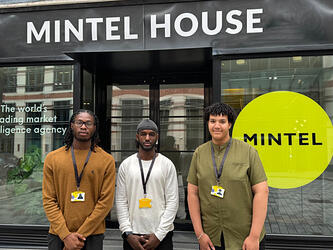Insight can help those leaping towards an agentic workforce

Earlier this year, trust expert Rachel Botsman's Roots of Trust installation at London’s Design Biennale helped to reimagine the world’s first organisational chart, designed in 1855.
The org chart was the centre of this installation, with experts predicting that it’s about to see the most radical changes in its 170-year history due to agentic AI joining the workforce. Whether or not this happens hinges on what Botsman calls ‘a trust leap’.
A trust leap is a moment or decision to embrace uncertainty and take a risk by believing in, or relying on, something or someone without complete evidence or certainty.
Salesforce made this leap regarding agentic AI. It recently became the latest company to reimagine its org chart by making 4,000 job cuts, with AI stepping in.
But not all businesses are Salesforce. And coming into 2025, Accenture’s Pulse of Change Index showed businesses feel less prepared for change than they did a year ago. This means not all businesses will take the trust leap and inject agentic AI into their workforce.
Insight teams can be pivotal in helping businesses understand if they should make the trust leap – with as few evidence gaps as possible – and use agentic AI in customer facing roles. Here’s how:
- Connecting EX and CX
In 1990 Sharp Healthcare CEO Michael Murphy stated that it wasn’t possible to give patients a high quality experience if the firm didn’t give its staff an employee experience where they felt valued and empowered. Work by Gallup has since reinforced this.
Insight teams – who often focus on the market or customer – should expand their remit to understanding employees to see if this rings true in their business. Because if it does, businesses will need to reflect it in how agents are trained and managed.
- Identify the human and agentic moments
As agents enter the workforce, businesses will have to decide where they have agentic touch points and where they have human ones. This means understanding where consumers expect human touch points, and where there’s a chance to surprise and delight with a human touch point where competitors don’t have one.
Understanding how to match moments with interaction type needs insight, especially to identify the moments where a business is risking customer churn or can generate loyalty. These will be the moments where businesses will need humans – not agents.
- Understand signalling
Agentic workers are cheaper than human ones, meaning that using them is an efficiency and cost reduction exercise. However, insight teams need to help businesses understand moments where embracing the change from human to agentic ‘workers’ risks falling foul to the ‘doorman fallacy'.
The ‘doorman fallacy’ is the term Rory Sutherland uses to describe how a hotel may replace a door attendant for an electric door to save money, but in doing so, removes a doorman’s intangible value: hailing taxis, recognising customers and signalling the hotel’s status. There is a risk of adopting agentic customer facing ‘workers’ that a cost-saving estimate won’t pick up on.
- Learning to leap little-by-little
Humans don’t like change. Customers won’t like the change of going from interacting with humans to being entirely interacting on agents if business make the shift too fast and too dramatically.
This means that insight teams need to be able to understand the phasing and order in which business put agents in customer facing roles and advise accordingly.
Phasing out of other technologies can give us some guidance. Videos took 15 years to phase out, cheques 11 years and diesel cars five years. is important because it gives people a frame of reference for how long big changes should take.
- Identify where leaping = losing
We’re all influenced by what others do. This applies to business decisions as well as personal ones. This means often businesses will make decisions based on what their competitors do. Or what how businesses they aspire to be like act.
This is amplified when – like with agentic AI – the decision can increase profits via cost cutting. Insight teams have a role – and responsibility – to ensure that business leaders aren’t swayed by what the category is doing, or what the finance department says the benefits are.
The positives from agentic AI in customer facing roles are obvious, the negatives less so. Insight teams should support business decisions in this area by understanding the rewards and risks of embracing this change, even if doing so means contradicting wider businesses’ thoughts.
Alex Holmes is director at Shape Insight

We hope you enjoyed this article.
Research Live is published by MRS.
The Market Research Society (MRS) exists to promote and protect the research sector, showcasing how research delivers impact for businesses and government.
Members of MRS enjoy many benefits including tailoured policy guidance, discounts on training and conferences, and access to member-only content.
For example, there's an archive of winning case studies from over a decade of MRS Awards.
Find out more about the benefits of joining MRS here.













0 Comments